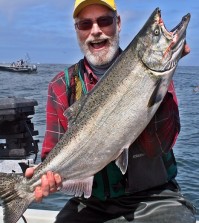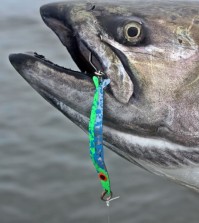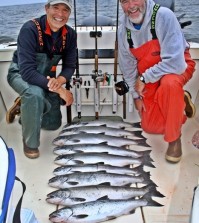Saltwater Chum Fishing
The fall runs of Chum salmon start to return in September and by mid-October, literally hundreds of thousands of these salmon will be migrating their way through Puget Sound. While chum are often caught at terminal fisheries on Hood Canal, they are usually ignored by saltwater sports fishermen. Pound for pound they may be the hardest fighting salmon of all five species.
There are two problems with Chum that affect their popularity with sports fishermen. The first is that their taste is entirely different (much milder) than the other species of salmon. The second and possibly the most important reason is that sports fishermen don’t understand how easy Chum are to catch in saltwater.
The freshwater angler has little, if any, problem hooking chum until your arms ache. The saltwater angler faces another problem, the vastness of the area where you will find them. Finding the chums in the first place defines how successful your fishery will be. Chums may be in deep water, but often can be in very shallow shoreline water, thus giving the beach angler and the car-top boater an opportunity for some excellent angling.
Fortunately, schools of chum will show themselves by jumping and splashing. The Chum angler in order to maximize his time on the water should keep a sharp eye out and look for schooling Chum before ever putting a lure in the water. Once located, follow a few simple rules and get ready to hang on.
Rules for saltwater chum fishing:
Rule One: Most chum will be in the top 60 feet of water. Concentrate your fishing there, while paying close attention to the top 30 feet of the water column. The majority of the chum runs return on the west side of Puget Sound.
Rule Two: Slow troll. Troll as slow as possible, and then try to go slower. Dodgers are made to troll slow, so this may be the one time they will out-fish flashers. Normally, in order to fish effectively, flashers need to rotate. For Chum, that is not necessarily so, but sometimes with plastic flashers such as Hot Spots, they are next to impossible to stop rotating.
If you are using flashers, try to stay away from glow colors, as Chum are prone to strike anything that is green. They often will grab the flasher, resulting in terrific strikes and no hook-ups.

#2 chrome edger
Rule Three: Use lures that appeal to Chum. Chum are for the most part plankton eaters. As they return to spawn, they seem to develop a taste for herring. Chum are also attracted by lures in green, purple, and hot pink colors. The closer they are to their spawning streams, the more likely they are to take herring. Up until then, artificial lures are the most effective.
Since Chum are plankton eaters, small mini squid (usually called Mini Sardines or Michael Bait) are usually the most effective. Add shrimp Smelly Jelly to your squid leader and flasher or dodger.
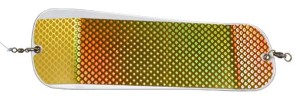
large clear/gold flasher
Chum respond to colors, especially greens, purples and hot pinks. I’ve found the most effective mini squid colors are distributed as Gold Star (Silver Horde) Mini Sardine in the following colors. Green is always a good choice, color number in Mini Sardine is F54R. Purple has become my first choice for Chum, Mini Sardine FG138R. Last, but not least, a Michael Bait in color number MB181. If your tackle box lacks these colors, use green or purple squid and cut the tentacles by half. Rig these Mini Sardines with a 6/0 to 9/0 black or blue hook. These should be fished on a 23″ to 26 leader. If you can’t troll slow, lengthen the leader by 6 inches. Ideally, slow troll, Smelly Jelly, Hold On!
Moochers can also do well targeting Chum. Moochers should fish the brackish saltwater areas off river mouths.
One of my cohorts at Salmon University usually anchors in 6 to 10 feet of water at the mouth of the Nisqually. He rigs a herring below a dink float with about two to three feet of leader below. He pinches a split shot about a foot above the herring. Cast your herring out, let it drift and don’t spill your Guinness Stout when your rod tip slams down.
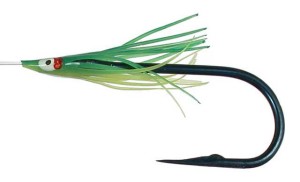
mini Sardine in F54R color on a 9/0 blue hook
Chum is currently being marketed by the commercial fishing industry under the name of Keta, the Latin name for Chum. Chum is best prepared smoked. To achieve their excellent flavor, take good care of your fish once caught. Bleed your Chum immediately upon catching. Clean and ice down your catch within 15 minutes after netting.
When smoking your catch, two pans of chips is usually enough, then finish your Chum by putting it into your kitchen oven at its lowest setting for two hours. Place a drip pan under the fish as Chum retain a lot of fat. When done, eat, enjoy and tell your friends its Keta.
Good areas to fish for Chum include Point No Point, Jeff Head, Vashon Island, Snohomish River system, Gig Harbor, and the southern river systems such as the Puyallup, Nisqually and Chambers Creek area.




